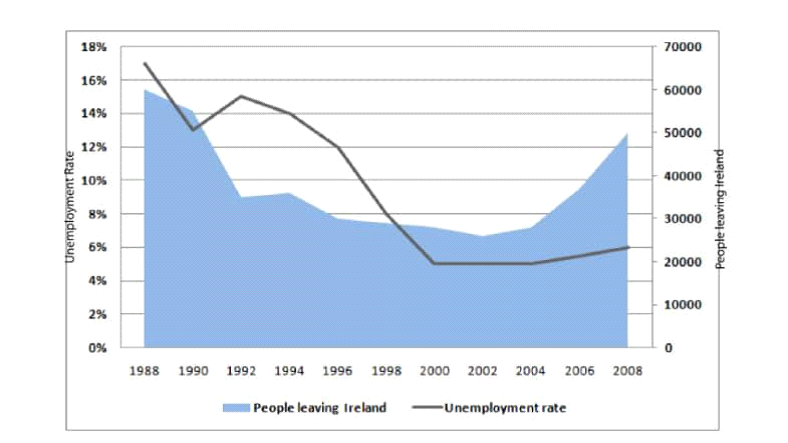ĐỀ WRITING NGÀY 14/9/2019
Task 1:
The chart below shows the unemployment rate and the number of people leaving Ireland from 1988 to 2008.
Nhận xét sơ bộ trước khi viết: tỉ lệ thất nghiệp ban đầu cao, số người rời bỏ đất nước cao (là chuyện thường) nhưng sau đó từ năm 90 tỷ tệ thất nghiệp tăng nhưng số người rời đi lại giảm, sau năm 92 thì tỷ lệ thất nghiệp giảm mạnh vs số người rời Ireland giảm nhẹ hều, giai đoạn cuối tỉ lệ thất nghiệp nhỉnh lên có 1 tí mà bà con ồ ạt kéo nhau đi khỏi Ireland. Nói thật chứ ai làm ra cái graph này chắc chỉ để kết luận không có tương quan rõ ràng giữa tỉ lệ thất nghiệp với số người rời Ireland. Nhưng ngoài sự thiếu tương quan, cái overview phải viết sao cho nó hiện lên nét chính là cao => giảm => tăng lên lại.
Loại biểu đồ: trộn chung wedge shaped graph và line graph nên gọi chung là graph/chart là chuẩn.

The graph illustrates the unemployment rate in comparison with the number of people leaving Ireland between 1988 and 2008.
According to the graph, the top unemployment rate of Ireland, around 17% was found in 1988. Then it dropped to about 13% in 1990. However, the rate shot up to a peak of 15% in 1992 before dropping to a low of approximately 5% in 2000, stayed almost unchanged till 2004 and rose marginally to 6% in 2008.
As for the number of Irish emigrants, most of them (just below 60,000) left their country in 1988, and the move of the population out of the country experienced a downward trend after that. However, despite a hike in unemployment rate in 1992, the number of Irish people moving to live abroad that year continued to plunge to a new low of about 35,000 people. The figure then fell more slowly to a bottom of around 27000 in 2002 before shooting up to a high of 50,000 people in 2008.
In general, there was no clear correlation between the employment and the movement of Irish people to other territories; however, there is a common pattern of the figures which started highest and then dropped to the lowest point before recovering. (207 words)
Task 2:
Some people think that cultural traditions will be destroyed if they are used as money-making attractions aimed at tourists. Others, however, believe that is the only way to save these traditions. Discuss both these views and give your own opinion.
Some believe it is detrimental for cultural traditions if they are turned into a cash machine for tourism, while others think the opposite. This essay will look at both of these viewpoints to clarify the importance of cultural commercialization (thương mại hóa văn hóa) in retaining traditions and then will suggest protective measures (biện pháp bảo vệ) in limiting the downside.
It is negative in some ways for local cultural traditions when they are used to develop tourism. First, the attraction of cultural uniqueness is immeasurable when it magnets (thu hút) thousands, and even millions of people the world over to come and experience new ways of life. The visitors will bring with them their own cultures and needs which should be accommodated. (đáp ứng nhu cầu) This will somehow lead to excessive cultural integration (giao thoa văn hóa) which may undermine (làm suy yếu) or disrupt (làm rối loạn) the local tradition. Second, the economic development allows local people to change their jobs and improve their living conditions, so the local may build concrete houses to replace cottages, and make souvenirs instead of doing farm work. The traditional lifestyle and culture attached to the old village and farming may, therefore, diminish. (giảm)
However, highlighting cultural traditions is also necessary in keeping them alive. Indeed, when a feature of tradition is identified as appealing, (hấp dẫn) introducing it to tourists is a good way to emphasize its value and arouse (khơi dậy) the awareness of cultural protection in the local people. For example, when Hue court music, (Nhã Nhạc Huế) the Vietnamese royal music, is performed for tourists on boats on Huong river, people will start to fear that one day the music may disappear and thus take actions to conserve it. Moreover, more records will be kept about such tradition through publications (ấn phẩm xuất bản) of all kinds ranging from tour information on leaflets or travel blogs, to videos of real cultural experiences of tourists, and cultural or tourism books. These are safe houses (nơi trú ẩn an toàn) to prevent these traditions from losing in part (mất 1 phần) or disappearing altogether. (biến mất hoàn toàn)
In conclusion, it is the economic development of the tourist spots that may harm the local culture rather than the emphasis on cultural traditions in attracting visitors. However, when introducing local culture to travelers, people need to keep a certain separation (sự tách biệt nhất định) of the tourist site from the local community to avoid too much cultural integration and constantly organize cultural conservation programs to protect their origin and uniqueness. (376 words)

